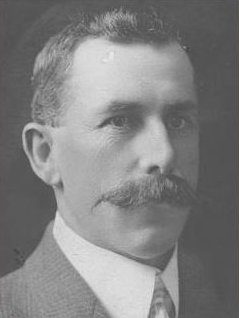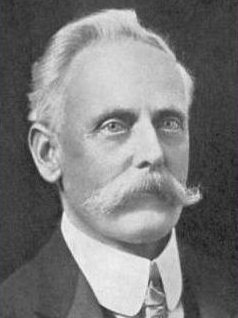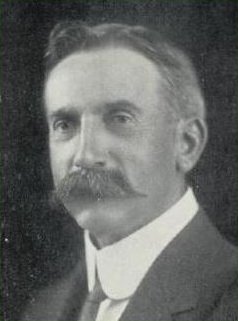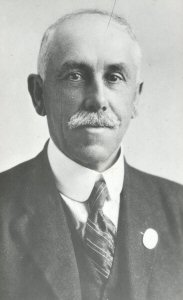Last updated on January 26, 2024
The man shown here is Llewellyn Atkinson. He was the Country Party member for Wilmot (Tas) from 1921 until 1928.
He’s been dead since 1945 and now not even Nationals leader Michael McCormack knows that he was the last Country Party member from Tasmania.

Llewellyn Atkinson; Photo credit: Psephos
Yesterday, Tasmanian Senator Steve Martin joined The Nationals. Elected in a recount of Jacqui Lambie Network votes a few months back, Martin briefly sat as an independent before signing up to the former Country Party.
Martin was welcomed into the party room yesterday as the first-ever Country Party/Nationals senator from Tasmania.
According to an ABC report, McCormack told the media: “The last National Party member in parliament (from Tasmania) was William McWilliams, a former Country Party leader all the way back in 1927.”
Umm, no. McWilliams left the Country Party in 1922 and only returned to Parliament in 1928 as an independent.
The misinformation was dutifully repeated by Guardian Australia and The Australian.
The Land also repeated the fake history and then made it worse by suggesting that McWilliams had been the Country Party’s “inaugural leader in 1903”, at least fifteen years before the party was formed.
In a variation on the theme, The Conversation told us there had been no Country Party representation in Tasmania “since the early 1920s, when William McWilliams was briefly leader of the Country Party”.
Again, no. There were two lower house Country Party members – in Braddon and Wilmot – between 1921 and 1928.
McWilliams Wasn’t Around In 1927
In 1927, McWilliams was out of parliament. After being elected to Franklin in 1903 as a Revenue Tariff candidate, McWilliams was variously a Free Trade/Anti-Socialist member (1906-09), a Liberal (1909-17) and a Nationalist (1917-20). He then joined the Country Party and became its leader in February 1920. After internal differences, McWilliams was replaced as leader in April 1921. At the 1922 election, running as a Country Party candidate, he lost his seat to the Nationalist candidate, Alfred Seabrook.

William McWilliams; Photo credit: Psephos
McWilliams then returned to the Nationalist Party and unsuccessfully contested Franklin in 1925. There were two Nationalist candidates in that election, a practice not uncommon in those days, and Seabrook was comfortably re-elected.
In 1928, McWilliams regained Franklin as an INDEPENDENT, defeating two Nationalist candidates, including Seabrook.
The following year, McWilliams was one of a group of members who supported Billy Hughes in his revenge attack on Stanley Melbourne Bruce, voting to defeat the Bruce-Page coalition government in the House of Representatives on September 10, 1929. The former leader of the Country Party voted to bring down the first government to ever include Country Party members.
McWilliams was re-elected to Franklin at the October 1929 federal election, again as an independent. He died ten days after the election and the newly-elected Scullin Labor government won the ensuing by-election. It was the last time a government has won a seat at a by-election that it didn’t already hold.
Joshua Whitsitt, Country Party Member for Braddon 1922-25
In 1922, Joshua Whitsitt won the seat of Darwin, centred on Devonport and now known as Braddon.

Joshua Whitsitt; Photo credit: Psephos
Whitsitt had spent 13 years as a state MP before contesting Darwin for the Country Party. He defeated the Nationalist member George Bell in 1922 but Bell returned the favour in 1925 and continued representing the electorate until 1943 when he was succeeded by Enid Lyons, the first woman member of the House of Representatives.
Llewellyn Atkinson, Country Party Member for Wilmot 1921-28
Between 1921 and 1928, Llewellyn Atkinson represented the seat of Wilmot in central Tasmania. The seat is now known as Lyons.

Llewellyn Atkinson; Photo credit: Parliament of Tasmania
Atkinson had first won the seat in 1906 as an anti-Socialist candidate. Like many others, he was a Liberal and then a Nationalist, before defecting to the Country Party in 1921. He served in Stanley Bruce’s ministry between 1923 and 1926.
Interestingly, there were three Country Party candidates in Wilmot in 1922. They polled a combined vote of 43.9% against a Nationalist and an ALP candidate. After preferences, Atkinson won easily with 61.2% of the two-party vote.
In 1925, Atkinson comfortably beat off a challenge from the ALP and two Nationalist candidates. However, by 1928, the Country Party had effectively folded in Tasmania. Atkinson rejoined the Nationalists and easily won a contest against the ALP and another Nationalist.
It’s possible Atkinson left the Country Party in 1927 but I have no way of verifying that. So let’s not quibble about 1927 being the last year of Country Party representation in Tasmania. But it wasn’t McWilliams.
My Whinge
I just wish I could trust someone to get the history right. It’s a trivial matter in one sense but I do keep asking myself whether anyone ever reads any history and whether anyone bothers to check easily verifable information. The period in question is rich in political personalities, political machinations and policy issues. My understanding of contemporary politics has been enhanced enormously by reaching into the entrails of our early history. It’s not as long ago as you might think and things haven’t changed as much as we, in our blinkered arrogance, might like to believe.
Update May 29, 2018: Michelle Grattan has kindly notified me of a correction she has made to her article on The Conversation.
